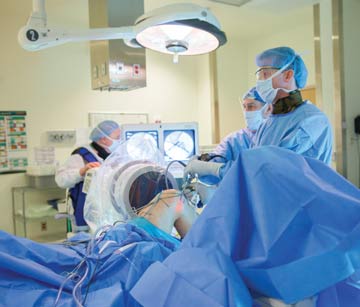The next time you need a lesson in radiation safety, pop your head into a procedure room to watch an interventional pain doc at work.
“They’re in front of C-arms all day long, so they respect imaging’s invisible dangers,” says Daniel Kaplan, DO, an orthopedic surgeon at WellSpan Orthopedics, York, Pa. “They step back from the imaging field and clear their hands during every shot, and they always wear the appropriate personal protection equipment. You can tell they’ve been fully educated on radiation safety and receive continuous training.” Your surgeons and staff know the basics of radiation safety, but they might not fully appreciate the risks they face every time a C-arm is wheeled into the OR. No one on your team would consider working a case involving intraoperative imaging without wearing a lead apron, but do they always don leaded eye protection and thyroid shields? They should.
“The thyroid and eyes are extremely sensitive to chronic radiation exposure, which is believed to cause most papillary thyroid cancers and can lead to the formation of cataracts,” says Dr. Kaplan. “Surgeons understand that the eyes are vulnerable to radiation, but current options are bulky and uncomfortable, and they tend to fog up. I don’t wear mine consistently.”
If Dr. Kaplan, who has conducted extensive research on intraoperative radiation safety, isn’t fully compliant with wearing proper personal protection during procedures, where does that leave members of your surgical team? Perhaps a perceived lack of practical comfort, not awareness, might be causing them to go without the protection they need. That’s no longer a valid excuse, however.
“The latest versions of protective equipment are much improved, and much easier to wear,” says Michael Groover, DO, a reconstructive orthopedic surgeon at the Cleveland (Ohio) Clinic Foundation. “There’s no reason it shouldn’t be readily available — and used consistently.”
He says new leaded eyewear is designed for a better ergonomic fit, and the latest lead-equivalent full-body protective gear is lightweight and more comfortable than the heavy, standard-issue lead aprons. Also consider providing surgeons and staff with custom-fitted vest-skirt combinations that distribute the weight of the garments and provide full protection without putting added strain on backs and joints.
“That makes a huge difference during long cases,” says Dr. Kaplan. “I’m also much more likely to take better care of my customized garments, to store them properly after use, than aprons taken from the general stock.”
Dr. Kaplan and his colleagues in the OR wear a dosimeter badge on the thyroid shield and another on the inside of the protective vest, against the chest, to measure their levels of radiation exposure. The maximum annual dose surgical team members should be exposed to is 20 mSv for the body. The annual threshold is higher for the thyroid and eyes (150 mSv), and hands (500 mSv). Each month, monitor and document individual dosimeter readings to ensure team members remain under the annual threshold of acceptable exposure to radiation.
.svg?sfvrsn=be606e78_3)

.svg?sfvrsn=56b2f850_5)